
When you start a business, it's essential to think about who your target market is. This is the group of people you are trying to reach with your products or services. Defining your target market can help you focus your marketing efforts and make sure you are getting the right audience. When determining your target market, there are a few things to consider, including demographics and psychographics. So, who is your target market? Think about who you are trying to reach, and then figure out how to best get them.
Why do you have no idea who your target audience is?
Most people have certain assumptions about who their target audience is when marketing their products or services. They believe that if they are selling a product specifically for women, for example, or if their service caters to a particular demographic, most of their customers will be from that specific group. However, the truth is that many marketers don't clearly understand who their target audience is. There are several reasons for this lack of understanding.
For one thing, it can be not easy to define precisely what constitutes a target audience. It isn't always as simple as defining demographics based on age, gender, or income level; different segments of a population may have differing needs and priorities that need to be considered when doing market research and crafting marketing strategies. In addition, marketing itself has become much more complex and multifaceted over the years, with more options and opportunities available than ever before. This has left many marketers feeling overwhelmed and unsure where to begin when trying to identify and reach their ideal customer base.
Despite all these challenges, however, there are still plenty of effective ways to gain an understanding of your target audience. By conducting surveys and focus groups, analyzing data from previous campaigns, and using other market research techniques, you can get a clear picture of your target audience and what they're looking for. With this information in hand, you'll be able to fine-tune your marketing efforts to better reach and connect with your target customers.
Define your target market.
The first step in reaching your target market is to define who that target market is. This may seem like a daunting task, but there are a few different ways you can go about it. One option is to start by looking at your current customer base. If you already have customers, take some time to analyze them and identify any commonalities they might share. What demographics do they belong to? What needs and wants do they have? What motivates them to make a purchase? Once you've answered these questions, you'll have a better idea of the type of customer you're trying to reach.
Another approach is to look at your competition. See who they are targeting with their products or services, and then try to identify any gaps or unmet needs in the market that you can fill. You may also want to talk to potential customers directly through surveys and focus groups or ask for social media or your website feedback.
Ultimately, the key is to be open-minded and flexible when defining your target market. There is no one "right" way to do so; instead, it's about paying attention to the available data and insights and using them to inform your marketing efforts. With a clear sense of who you are trying to reach, you'll be able to better engage with your target audience and connect with them on a deeper level. And ultimately, that's what marketing is all about: reaching out and connecting with your ideal customers to resonate with them and set you apart from the competition. So go ahead and get started - the world of marketing is waiting!
Research your target market.
Now that you have a better understanding of your target market, it's time to start researching them. This will involve looking at general demographic information and specific data about their needs and wants. There are several different ways you can go about this research, but some of the most common include conducting surveys, focus groups, and interviews; analyzing data from previous marketing campaigns; and using market research tools like Google AdWords and Amazon's Mechanical Turk.
One of the benefits of conducting market research is that it can help you better understand your target market's needs and pain points. By getting to know your target customers, you'll be better positioned to craft marketing messages that resonate with them and offer them solutions to their problems. Additionally, this research can help you identify any potential gaps in the market that you can fill with your product or service.
No matter what methods you choose to use, the important thing is that you take the time to get to know your target market. The more information you have about them, the better equipped you'll be to reach them with your marketing campaigns.
Identify what matters to your target market.
Now that you know your target market and their needs, it's time to start thinking about what matters to them. What kind of values do they hold? What motivates them? What are their goals and aspirations? Answering these questions will help you to understand better what matters most to your target market and can help you to tailor your marketing messages accordingly.
One usefulhelpful way to start thinking about these things is to look at the competition. What are their values and beliefs? What kind of messaging do they use when trying to reach customers? Are there any gaps or unmet needs that you could fill with your products or services? By getting a sense of what resonates with potential customers, you'll have a better idea of what values matter most to them and how you can align your marketing efforts with those values.
Another essential thing to consider is who your target market looks up to. Do they have any role models or influencers that hold particular sway over their purchasing decisions? By understanding who your target market looks up to, you can more effectively connect with them and reach them through various marketing channels.
Overall, thinking about what matters most to your target market is essential for creating effective marketing campaigns that resonate with them more profound. So take the time to get to know the people you're trying to reach, and you'll be in a better position to build meaningful connections with them.
Tailor your marketing efforts to reach your target market.
Once you have defined your target market and researched their needs and preferences, it's time to tailor your marketing efforts to reach them effectively. This will involve using various tactics, including paid advertising, search engine optimization, content marketing, and social media marketing.
One of the most important things to keep in mind when tailoring your marketing efforts is that not every channel will be effective for every business. It's essential to experiment with different media and see which ones work best for you and your target market. Additionally, it's often necessary to use a combination of other channels to reach your target market.
For example, if you're trying to reach young adults, paid advertising on Snapchat or Instagram might be more effective than running ads on Facebook or Google. Similarly, suppose you're trying to get people interested in health and fitness. Creating blog posts and infographics about healthy living might be more effective than posting on Twitter or Facebook.
Ultimately, the key to effective marketing is taking the time to identify your target market and then tailoring your efforts to reach them effectively. So if you want to see actual results from your marketing campaigns, be sure to think carefully about who you're trying to connect with and what channels will give you the best opportunity for success.
Evaluate whether or not you're reaching your target market.
Once you've put in the time and effort to define your target market and start using various marketing tactics to reach them, you must evaluate whether or not those efforts are making an impact. This can be done through multiple methods, such as tracking website traffic and analyzing customer feedback.
When evaluating your marketing efforts, one important thing to keep in mind is that it's often necessary to make adjustments. For example, suppose you're using paid advertising and social media marketing but aren't seeing the results you'd hoped for. In that case, it might be worth experimenting with different targeting strategies or adding new channels. Suppose you're receiving negative customer feedback about a particular product or service offering. In that case, it may be time to reassess that product or focus more on improving your existing offerings.
Ultimately, evaluating whether or not you're reaching your target market can help you better allocate your resources and fine-tune your marketing efforts over time. So take the time to closely monitor your marketing performance and make necessary adjustments to continue improving your results.
Adjust your marketing strategy as needed.
As your business grows and changes, it's essential to periodically assess your marketing strategy to ensure that it's still aligned with your overall goals. Additionally, as you learn more about your target market and what works best for reaching them, you may need to adjust your strategy to continue achieving success.
For example, if you find that a particular marketing tactic is no longer as effective as it once was, it may be time to experiment with something new. Similarly, if you notice that your target market is shifting or changing somehow, you'll need to adapt your strategy accordingly.
Of course, making changes to your marketing strategy can be a bit of a risk. But if you're not willing to take risks, you'll never be able to innovate and improve your results. So if you want your business to succeed, it's essential to be open to changing your marketing strategy as needed.
Ultimately, the key to successful marketing is continuous optimization. By periodically assessing your efforts and making adjustments as needed, you can ensure that your campaigns are always aligned with your goals and that you're reaching your target market effectively. So don't be afraid to experiment and make changes to your strategy as you go - it's the only way to ensure that you'll continue seeing success in the long run.
It's clear that to be successful in any marketing; you need to know your target market. By researching and understanding your target market, what matters to them, and tailoring your marketing efforts specifically, you're much more likely to reach them. Of course, it's essential to periodically evaluate whether or not you are getting your target market and make changes as needed. Luckily, many different resources are available to help with this process, including our marketing courses! We hope these tips have been helpful, and we wish you the best of luck in reaching your target market.

Frequently Asked Questions
How do you explain who your target market is?
Defining the Target Market
The first step to explaining the target market is identifying the specific audience for the blog post. Analyzing their demographic and psychographic factors is a crucial aspect of recognizing the intended market.
Demographic Analysis
Demographics refer to the measurable characteristics of the group, including age, gender, income, education, and occupation. For instance, if the blog post aims to educate women aged 25-40 who work in professional industries, the demographic factors are explicitly defined to cater to this audience. By presenting the information in a manner that resonates with them, the blog post garners higher engagement levels and overall effectiveness.
Psychographic Analysis
Psychographic factors offer insight into the audience's interests, values, and opinions. For example, if the target market comprises environmentally-conscious individuals, the blog post may discuss sustainability and eco-friendly practices. Here, the author acknowledges the reader's values to deliver relevant content that aligns with their core beliefs. Delving into these facets helps in building rapport and enables the blog to become an essential resource for the audience.
Identifying Needs and Preferences
Moreover, assessing the target market's unique preferences and requirements allows the author to tailor blog content successfully. Identifying common problems or concerns among potential readers and addressing them in the blog post fosters trust, credibility, and loyalty. By offering practical solutions and indispensable information, the author demonstrates a deep understanding of the target market, subsequently nurturing the connection between the blog and its audience.
Considering Market Segmentation
Lastly, utilizing market segmentation techniques can further refine the target audience. This approach involves segmenting the audience into smaller sections based on specific attributes, rendering the blog more specialized and appealing to niche readers. By narrowing down the focus, the blog post can deliver content of higher quality and relevance, catering to the unique requirements of the segmented target market.
In conclusion, effectively explaining the target market entails a comprehensive understanding of its demographic and psychographic factors, preferences, and needs. Employing market segmentation techniques further fine-tunes the intended audience, enabling the blog post to resonate poignantly with readers and maximize its impact.
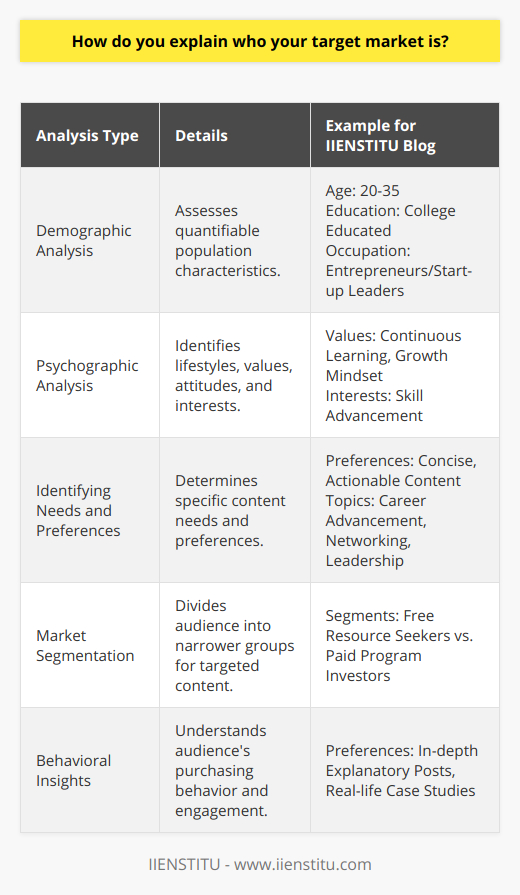
Who is your target market and how are you going to reach them?
Target Market Identification
The primary target market for the blog post consists of college students, recent graduates, and young professionals aged between 18 and 35 years. The focus on this demographic arises from their active engagement with online content, increased exposure to social media platforms, and their inclination towards information consumption.
Reaching the Target Market through Online Channels
To attract the intended audience, a strategic approach involves utilizing various online channels, such as social media platforms, email campaigns, and search engine optimization (SEO). Social media platforms, including Facebook, Instagram, Twitter, and LinkedIn, are crucial in sharing the blog post, given their high user engagement among the target audience. Tailoring the promotional messages to resonate with this demographic is essential in increasing content viewership and driving website traffic.
Search Engine Optimization Strategy
Another effective approach is optimizing the blog post for search engines, which significantly enhances online visibility. Implementing relevant keywords, original content, and appropriate meta tags contribute towards a higher search ranking. Additional efforts to enhance SEO include guest blogging on reputable platforms, obtaining backlinks from authoritative websites, and creating value for the audience through informative and helpful content.
Email Marketing for Enhanced Reach
Email marketing is a vital tool in reaching the target readers, as it involves direct and personalized communication with potential subscribers. Creating a compelling newsletter or regular updates can foster a sense of connection with the audience and encourage content consumption. Moreover, offering exclusive information, updates, or promotions to email subscribers builds loyalty and reinforces the value of the blog to its readers.
In conclusion, the target market of college students, recent graduates, and young professionals necessitates a multi-faceted approach to reach them effectively. Utilizing online channels like social media platforms, SEO techniques, and email marketing, the blog post can extend its reach, thus garnering increased engagement and brand recognition.
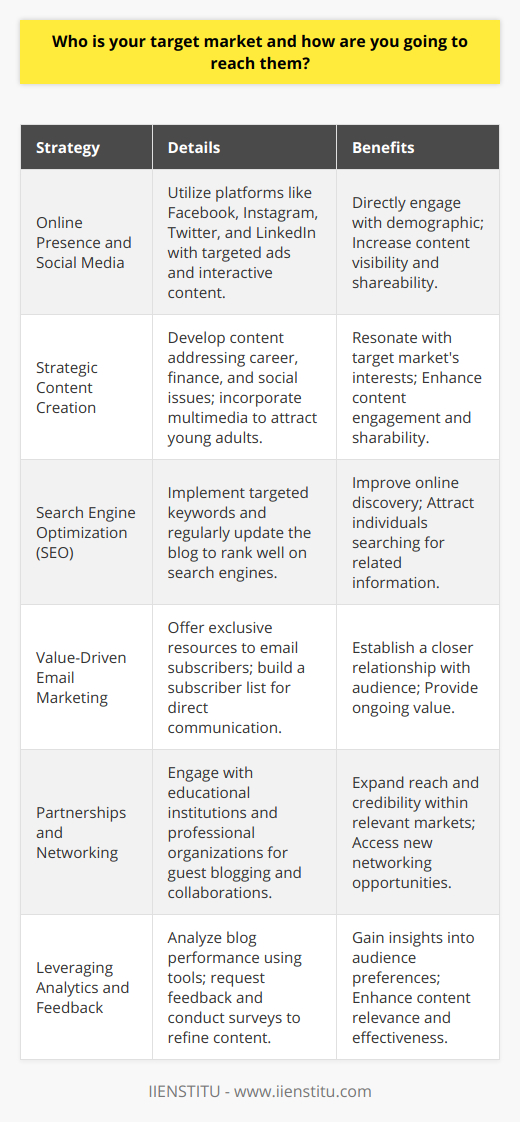
How do you reach out to your target market?
Understanding the Target Market
To effectively reach out to a target market, one must first have a comprehensive understanding of that specific group of potential customers. This involves conducting thorough market research, including surveys, interviews, and focus groups to gather insights into their demographics, psychographics, preferences, needs, and behaviors.
Effective Communication Channels
Upon identification of the target market, selecting the most effective communication channels becomes crucial to ensure the dissemination of the blog post to the desired audience. Assess existing digital channels such as social media platforms, website traffic analytics, email lists, and search engine results and implement targeted campaigns through the channels that yield the highest engagement rate.
Tailored Content
Crafting tailored content with a focus on addressing the specific needs, preferences, and interests of the target market is essential to engage and retain their attention. Utilize the insights gained from market research to develop content that connects with the target audience's values, challenges, and aspirations. This may include diverse formats such as text, images, videos, and infographics to accommodate various learning preferences.
SEO Optimization
Optimizing the blog post for search engine visibility allows the target market to easily find the content through search engines. Incorporate relevant keywords, create engaging meta descriptions, and employ an effective link-building strategy to increase organic traffic and improve search engine rankings. Ensure that the blog is mobile-friendly, as a significant proportion of target audiences access online content through mobile devices.
Social Media Presence
Maintaining a robust social media presence across relevant platforms proves essential to engage with the target market, as it provides opportunities for sharing, commenting, and amplifying the reach of the blog post. Engage in conversations, share valuable content and utilize targeted advertising to maximize the blog's visibility within the target audience.
Partnerships and Collaborations
Form strategic partnerships and collaborations with influencers, industry experts, or parallel businesses within the target market to expand the blog's audience. By connecting with established networks that already have a rapport with the target market, the blog's content becomes more trustworthy, relevant, and shareable.
In summary, reaching out to a target market requires a thoughtful approach that combines thorough market research, effective communication channels, tailored content, search engine optimization, social media presence, and strategic partnerships. By employing these strategies, the blog post can be effectively promoted to engage and convert the desired audience.
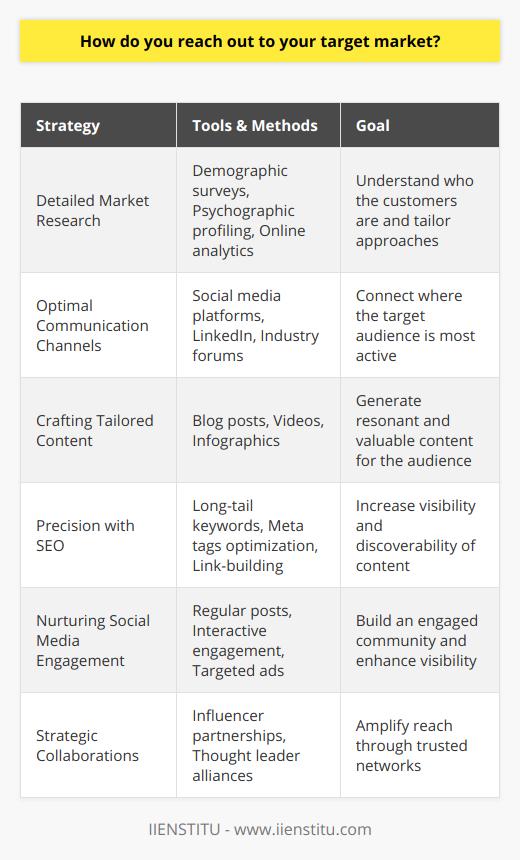
How do you define your target market in the context of your overall business strategy?
Defining the Target Market
In the context of an overall business strategy, defining a target market is the process of identifying and categorizing an optimal group of consumers who are most likely to engage with a company's products or services. This critical step aids businesses in strategically focusing their resources and tailoring their marketing efforts to maximize return on investment.
Demographics and Psychographics
To effectively define a target market, businesses must analyze demographic and psychographic factors, which characterize the specific attributes of potential consumers. Demographic factors include age, gender, income, occupation, and geographic location, while psychographic factors encompass personality traits, values, and lifestyle preferences. This step allows companies to segment their audience and craft targeted messages that resonate on a personal level.
Consumer Needs and Preferences
It is also essential to understand the distinct needs, preferences, and problems of potential customers. This can be achieved through market research strategies such as surveys, focus groups, and interviews, generating valuable feedback and insights. Armed with this information, businesses can design or adjust their products, services, and marketing efforts to address consumer needs more effectively and stand out from competitors.
Competitive Analysis
Understanding the competitive landscape is vital in defining a target market. By conducting a comprehensive competitive analysis, businesses can identify gaps, opportunities, and threats that impact their offerings. Furthermore, they can assess the competitors' strengths, weaknesses, and target markets to establish their unique selling points (USPs), which can be leveraged to gain a competitive advantage.
Monitoring and Adapting
Lastly, it is crucial for companies to continuously monitor their target market's dynamics and adapt their strategy accordingly. This should involve tracking changes in consumer behavior, preferences, industry trends, and competition, followed by making informed decisions on product development, communication strategies, and branding. In turn, this ongoing process will position companies for sustained success in the long run.
In conclusion, defining a target market involves the integration of demographic, psychographic, and consumer behavior factors with a comprehensive understanding of the competitive landscape. It serves as a foundation for businesses to build their marketing strategies and develop unique value propositions, ensuring that their resources' allocation and marketing efforts generate the desired outcomes. Constant monitoring and adaptation are vital, contributing to the company's long-term success in the face of evolving market dynamics.
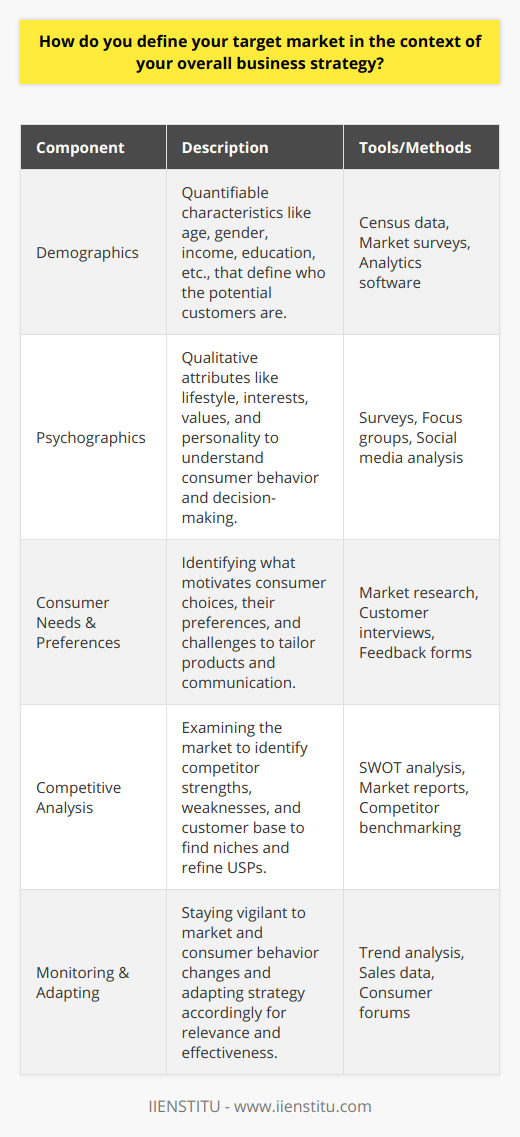
What are the most effective methods for determining who your customers are in terms of target market?
Identifying the Target Market
One of the most crucial aspects of running a successful business is determining who your customers are. This process involves identifying customer demographics, interests, and behavior, which is collectively referred to as the target market. Identifying the target market is essential for tailoring marketing strategies and delivering products or services that cater to customer needs. There are several methods to achieve this, some of which are more effective than others.
Market Research
Market research plays an essential role in identifying customer demographics and characteristics. This process includes surveys, interviews, focus groups, and observational studies, enabling businesses to gather valuable information that helps them analyze their ideal customer profile.
Advertisement Analytics
By examining advertisement performance, businesses can gain crucial insights into customer preferences and market trends. It involves evaluating the effectiveness of different advertising channels and ad campaigns to assess their impact on attracting the desired target audience. Moreover, by analyzing customer behavior and engagement metrics, companies can further refine their marketing strategies.
Social Media Analysis
Observing social media engagement and gaining insights through social listening tools can prove beneficial for identifying target customers. Social media platforms provide an opportunity to understand customer preferences, behaviors, and interactions, thereby refining the customer persona and tailoring marketing strategies accordingly. With this data, companies can engage in targeted marketing campaigns and build a loyal customer base.
Competitor Analysis
A comprehensive competitor analysis can provide valuable insights into the target market. By examining their marketing strategies, product offerings, and customer demographics, businesses can better understand their competition and identify gaps in the market to cater to unmet customer needs.
Website and CRM Analytics
Analyzing website and customer relationship management (CRM) data can provide significant information on customer behavior, preferences, and demographics. Web analytics enables businesses to track customer engagement, purchase patterns, and overall performance of online assets, thereby helping them identify their target audience more accurately.
In conclusion, determining the target market involves a multitude of techniques such as market research, advertisement analytics, social media analysis, competitor analysis, and website and CRM analytics. The implementation of these methods helps businesses identify their ideal customers, refine their marketing strategies, and launch tailored products and services, ultimately ensuring success in the competitive business landscape.

Can you provide three examples of ways to identify your target market that are both efficient and accurate?
**Market Segmentation**
One efficient and accurate way to identify your target market is through market segmentation. This method involves dividing the overall market into smaller groups based on shared characteristics, such as demographics, psychographics, or geographic factors. By analyzing these segments, businesses can focus their efforts on the most relevant and potentially profitable audiences, therefore increasing the likelihood of a successful marketing campaign.
**Social Media Analytics**
Another effective approach to pinpointing your target market is using social media analytics. By examining the interactions, follows, and shares on platforms such as Facebook, Twitter, and Instagram, businesses can gain insights into their audience's interests, preferences, and behaviors. Furthermore, this information allows companies to identify trends and patterns within their online community, for better understanding of potential customers and refining their marketing strategy accordingly.
**Consumer Surveys**
Lastly, conducting consumer surveys is a valuable and precise method for determining your target market. Through questionnaires, interviews, or online polls, businesses can gather essential data about their audience's preferences, needs, and opinions. Leveraging this feedback allows companies to tailor their products, services, and marketing campaigns to better appeal to their target demographic, ultimately leading to increased engagement, brand loyalty, and sales conversions.
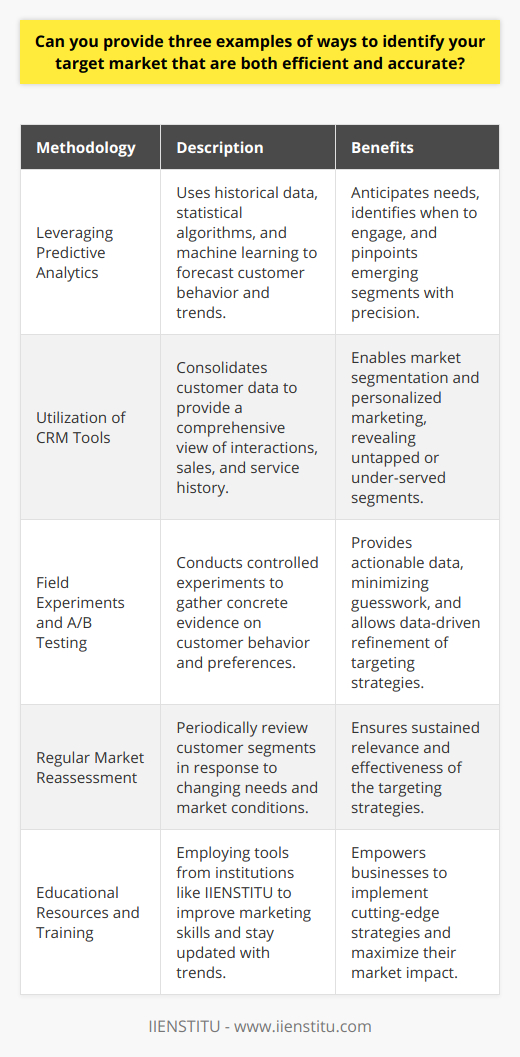
How do you determine who your customers are in terms of target market?
Identifying the Target Market
In order to effectively determine the target market for a blog post, it is essential to conduct thorough market research and analysis. This involves identifying the demographic, socioeconomic, and behavioral characteristics of potential customers, which enables one to narrow down the scope of possible audience segments.
Demographic Characteristics
Initially, evaluate demographic characteristics such as age, gender, and ethnic background. The content and tone of the blog post should be aligned with the preferences and interests of the specific demographic group that would benefit the most from the information provided.
Socioeconomic Factors
Next, consider socioeconomic factors such as income, education level, and occupation. These factors impact the purchasing power, preferences, and needs of your potential customers. Tailor your blog post's content and language to accommodate the educational background and literacy level of your target audience.
Geographic Location
Another important aspect is the geographic location of your target audience. This criterion may significantly influence their preferences, values, and interests, particularly when discussing culture-sensitive topics. Moreover, considering the region and time-zone differences will enable you to schedule and promote your blog post effectively.
Behavioral Patterns
Finally, examine behavioral patterns, which include attitudes, interests, and internet browsing habits of your potential customers. Investigative tools such as keyword analysis, social media listening, and web analytics can provide valuable insights into your target market's online behavior. This data will help you to create blog posts that resonate with your audience's values and preferences.
In conclusion, determining your target market requires identifying potential customers based on their demographic, socioeconomic, geographic, and behavioral characteristics. Thorough market research and analysis will facilitate the creation of relevant and engaging content that effectively reaches and satisfies the needs and interests of your target audience.

What are 3 ways you can identify your target market?
**Demographic Analysis**
One method for identifying your target market is conducting a demographic analysis. This involves examining the characteristics of your potential audience, such as age, gender, education level, and income. Understanding these factors can help you tailor your blog post's content and promotional strategies to attract readers who are most likely to be interested and engaged.
**Psychographic Profiling**
Another approach to pinpointing your target market is through psychographic profiling. Instead of focusing on demographics, psychographics delve into the values, interests, and lifestyles of potential readers. By connecting with individuals on this deeper level, you can create content that resonates with their emotions and beliefs, cultivating a loyal audience who is more likely to share and promote your blog post.
**Competitor Analysis**
Finally, examining your competitors can provide valuable insights into your target market. By exploring the strategies and tactics used by successful blogs in your niche, you can identify trends and gaps in the market. This information can ultimately inform your blog post's topic, style, and distribution methods, ensuring you are well-positioned to attract and retain readers within your chosen target market.

How do you define your target market in relation to your competitive landscape?
Defining Target Market
To define the target market in relation to the competitive landscape, it is crucial to identify the specific group of customers who would potentially be interested in utilizing the services or products offered by the blog. This can be achieved by analyzing the market's demographics, psychographics, and purchasing behaviors. Demographics include features such as age, gender, income, and education, while psychographics involve understanding customers' interests, opinions, and attitudes.
Assessing the Competitive Landscape
Furthermore, conducting an assessment of the competitive landscape enables blog owners to identify other blogs or platforms that cater to similar audiences or interests. A thorough competitor analysis should focus on evaluating competitors' offerings, strengths, weaknesses, and market positions. This information allows blog owners to differentiate their blogs and develop unique value propositions that better serve customers' needs, which ultimately aids in securing a competitive edge within the market.
Understanding Market Segmentation
Market segmentation also plays an essential role in defining the target market in relation to the competitive landscape. Segmenting the market involves dividing the broader target audience into smaller subgroups based on shared characteristics or preferences. By focusing on specific market segments, blog owners can tailor their content, marketing strategies, and offerings to align with the unique needs and preferences of these groups, increasing the likelihood of attracting and retaining loyal readership.
Utilizing Customer Feedback
Lastly, incorporating customer feedback when defining the target market is indispensable. Actively seeking input from existing and potential customers during the blog's development stage provides valuable insights into their experiences, expectations, and needs. Such feedback allows for necessary adjustments to be made to the blog's content, design, and offerings, ensuring they are aligned with customers' preferences while distinguishing the blog from its competitors.
In conclusion, defining the target market in relation to the competitive landscape is a multifaceted process that involves analyzing demographic and psychographic factors, assessing the competition, understanding market segmentation, and gathering customer feedback. By doing so, blog owners can effectively attract, engage, and retain a dedicated audience that appreciates and values the distinctive aspects of their blogs within a competitive environment.
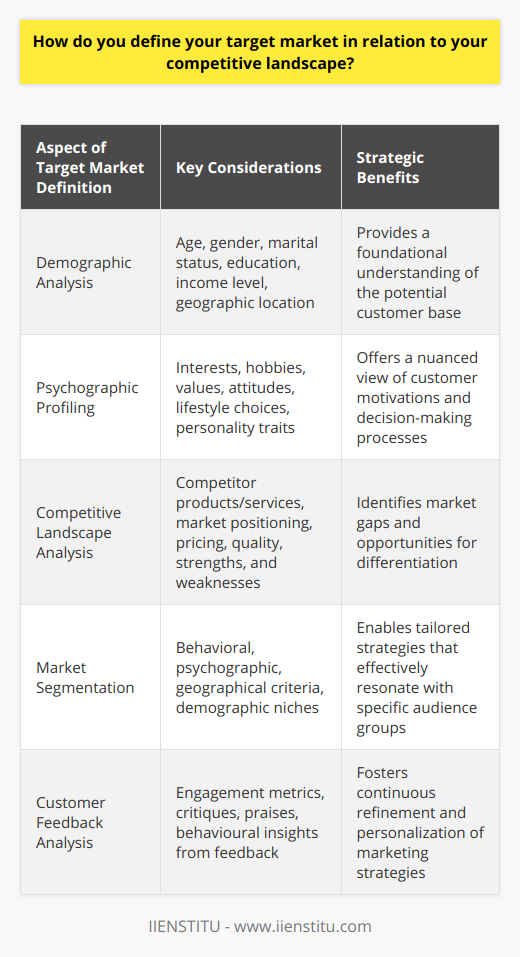
What are the key factors to consider when defining one's target market?
Defining the Target Market
Identifying Key Factors
When defining the target market for any product, service, or promotional campaign, it is essential to consider several key factors. First and foremost, one must identify the target audience's demographic profile, which includes factors such as the age, gender, income level, occupation, and education level of potential customers. This information helps marketers refine their message, tailoring it to the needs and preferences of the target demographic.
Analyzing Psychographics
In addition to demographics, understanding the psychographic characteristics of the target market is crucial. Psychographics refers to the interests, values, attitudes, and lifestyles of consumers. This information provides insights into potential buyers' purchase-related motivations, allowing marketers to develop more effective strategies and tactics to entice them. Identifying target market psychographics can be a valuable resource in crafting compelling sales pitches and promotional content.
Geographic Location
Another significant factor is the geographic location of the target market. This aspect considers the physical location of potential customers, including regions, countries, and urban or rural settings. Geographic information helps businesses design targeted marketing campaigns that resonate with a specific location's culture and preferences. Moreover, understanding local competition, market regulations, and demand patterns helps brands make informed decisions about their market entry strategies.
Product or Service Demand
Understanding the demand for the product or service within the target market plays a critical role in defining marketing objectives and setting sales targets. It is essential to ascertain the size of the target market, determine its growth potential, and assess the need for the product or service. This information can be obtained through market research, competitor analysis, and industry trends, providing a foundation for effective marketing strategies.
Competitor Analysis
Finally, analyzing the competition is a vital aspect of defining a target market. Businesses must identify both direct and indirect competitors within the target market and understand their strengths, weaknesses, and unique selling propositions. Evaluating competitor performance, market share, and customer perception allows marketers to position their offerings more effectively, differentiate their brand, and tailor their marketing tactics to capture a larger share of the target market.
In conclusion, the process of defining a target market involves various key factors, including demographics, psychographics, geographic location, product or service demand, and competitor analysis. A thorough understanding of these factors allows businesses to design more effective marketing strategies, tailor their message to the needs and preferences of the target audience, differentiate from competitors, and ultimately achieve their marketing objectives.
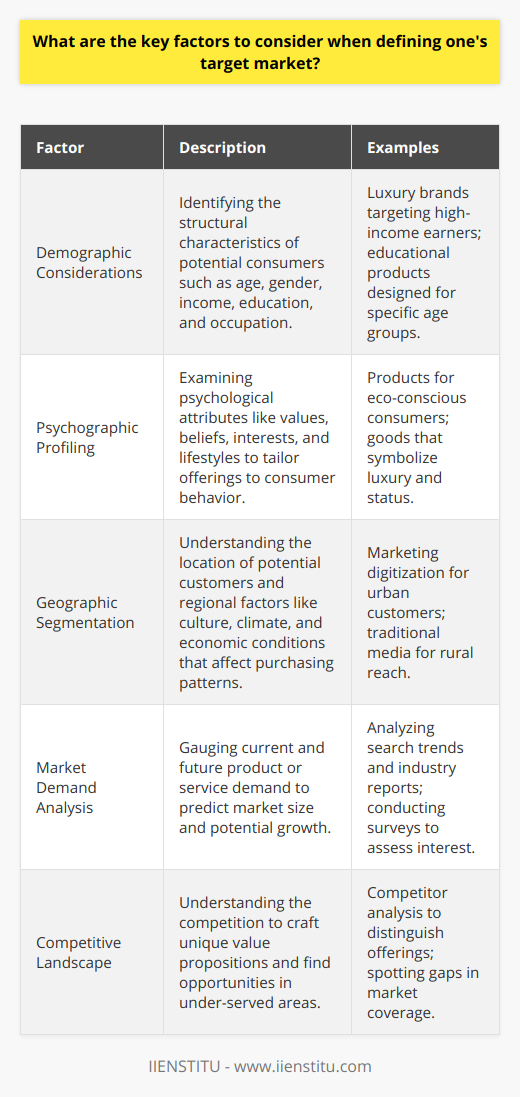
What are the most effective research methods to gather data on customer demographics, behaviors, and preferences in the context of target market identification?
Understanding Customer Demographics
One highly effective research method to gather data on customer demographics is conducting surveys. This method enables the collection of valuable quantitative data, such as customers' age, gender, and income, which is essential for understanding the target market profile. Additionally, it can provide insights into customers' behavioral patterns and preferences.
Observing Consumer Behavior
Another method is utilizing observational research, which entails observing customers in real-world situations. This includes both in-store observations and online analyses of web browsing patterns. Through this approach, researchers can identify how people interact with products, services, and brands, helping marketers develop targeted marketing strategies based on observed behaviors.
Leveraging Social Media Analytics
Exploiting social media analytics plays a critical role in studying consumer preferences and trends. By analyzing social media interactions, businesses can identify customer sentiments and preferences regarding specific products, competitors, and industry trends. Social media analytics tools allow companies to monitor their online presence and assess customer satisfaction levels, giving them valuable data on consumer preferences.
Conducting Focus Groups
Focus group discussions are a qualitative research method used to obtain in-depth information about consumers' views, behaviors, and preferences. By facilitating moderated discussions among a small group of participants, businesses can gather a wide array of perspectives on a product or service. The open and interactive nature of focus groups allows companies to probe deeper into customer preferences and generate meaningful insights.
Analyzing Purchase Data
Lastly, analyzing existing purchase data can help identify customer preferences and behaviors. By examining customer transactions, businesses can detect patterns and trends that provide insights into their target market's preferences. This data analysis helps companies to comprehend the factors influencing customer decisions and tailor their marketing strategies accordingly.
In conclusion, a combination of surveys, observational research, social media analytics, focus groups, and purchase data analysis are the most effective research methods to gather data on customer demographics, behaviors, and preferences. Employing these approaches allows businesses to understand their target market holistically, leading to more targeted marketing and improved customer engagement.
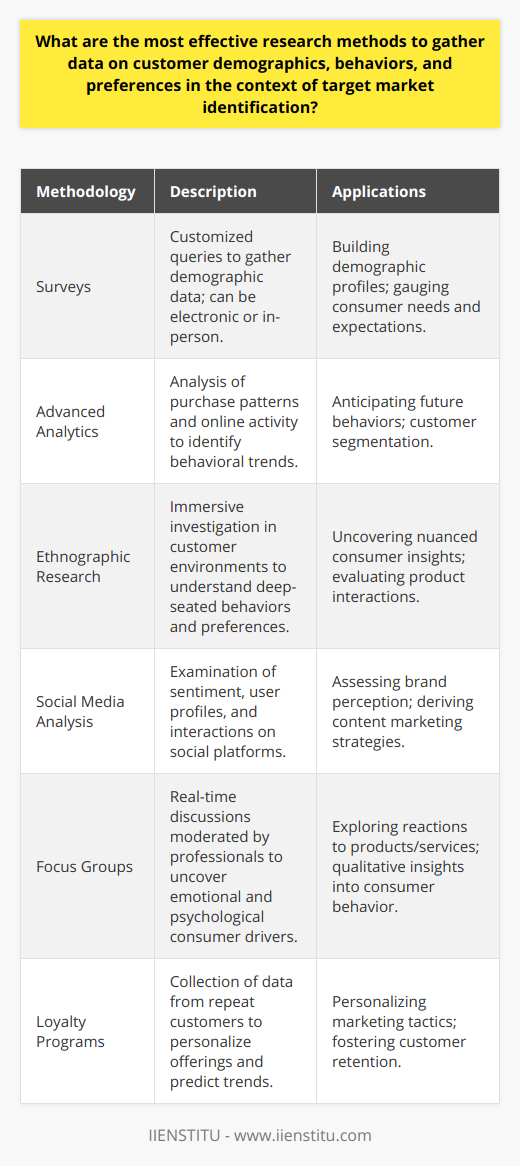
Can you explain the significance of psychographic factors in determining a business's target market and how they complement demographic factors in creating a comprehensive customer profile?
Psychographic Factors in Target Market Determination
Psychographic factors play a key role in determining a business's target market. These factors encompass the customers' values, attitudes, interests, and beliefs, which influence their buying behavior. By understanding their target audience's psychographics, businesses can create marketing strategies that resonate with customers on a deeper and more personal level.
Complementing Demographic Factors
Demographic factors, such as age, gender, and education, provide useful insights about a customer's external traits. However, demographic data alone is insufficient for creating a nuanced customer profile, as it may overlook the internal motivations that drive consumption. Psychographic factors complement demographic data by adding a psychological dimension to customer profiling, enriching the information businesses have to segment their market and tailor their offerings.
Insight-Based Marketing
Combining psychographic and demographic data allows businesses to craft comprehensive customer personas. By identifying and understanding the unique needs, motivations, and preferences of each persona, businesses can design and deliver tailored marketing messages that effectively engage customers. This insight-based marketing approach ensures that a company's message is relevant and personalized, increasing the likelihood of securing customer loyalty and driving long-term growth.
Conclusion
In summary, psychographic factors contribute significantly to determining a business's target market and complement demographic factors in creating a comprehensive customer profile. This multi-dimensional understanding of customers is essential for creating tailored marketing strategies aimed at achieving customer satisfaction, loyalty, and ultimately, business success.
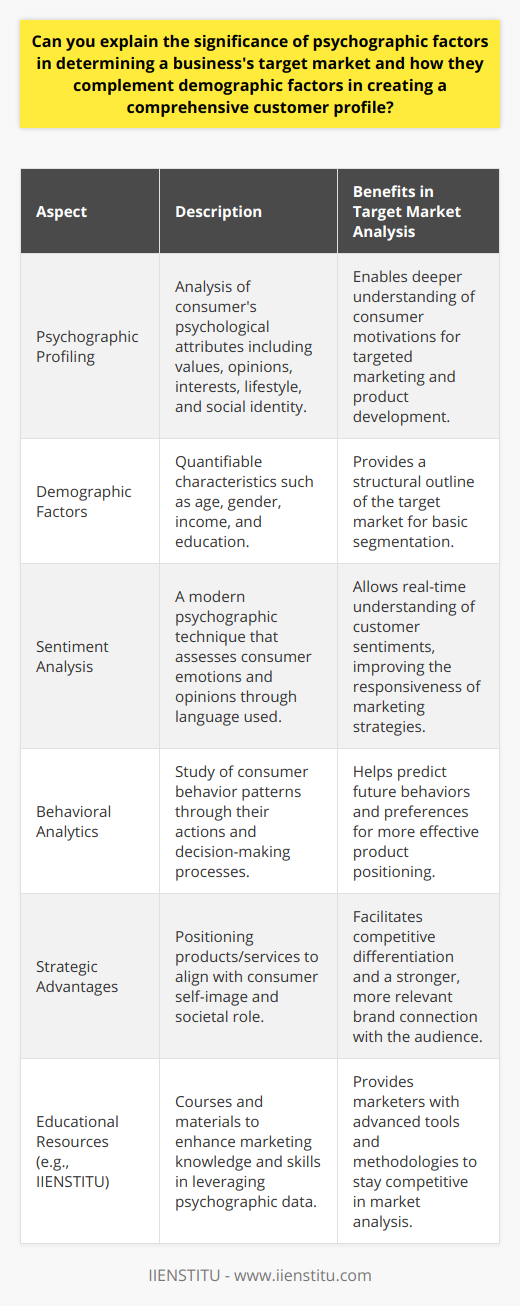
How can I define my target market using a combination of demographic, geographic, psychographic, and behavioral factors?
Understanding Target Market through Demographics
Define your target market by first examining demographic elements such as age, gender, marital status, occupation, and income level. Such information can guide your marketing strategies effectively.
Identification through Geographic Factors
Focus on your potential consumers' geographic location. It involves understanding the particular region, city, or even neighborhood where your potential customers live and work. Geographic factors can influence the needs and wants of your target market.
Utilizing Psychographic Information
Psychographics give attention to hobbies, interests, values, attitudes, lifestyle, and personality characteristics. These factors help businesses create a more rounded profile of their target customer. They facilitate businesses in tailoring products or services to meet target audiences' different needs, wants, or interests.
Influencing through Behavioral Factors
Lastly, utilize behavioral factors in shaping your target market. These encompass knowledge of consumers' behavior, usage rate, readiness to buy, loyalty status, and attitude towards certain products.
By incorporating demographic, geographic, psychographic, and behavioral factors, you can effectively identify and understand your target market. By doing so, you ensure your marketing strategy aligns more closely with your audience's needs and wants, leading to both increased customer satisfaction and business success.
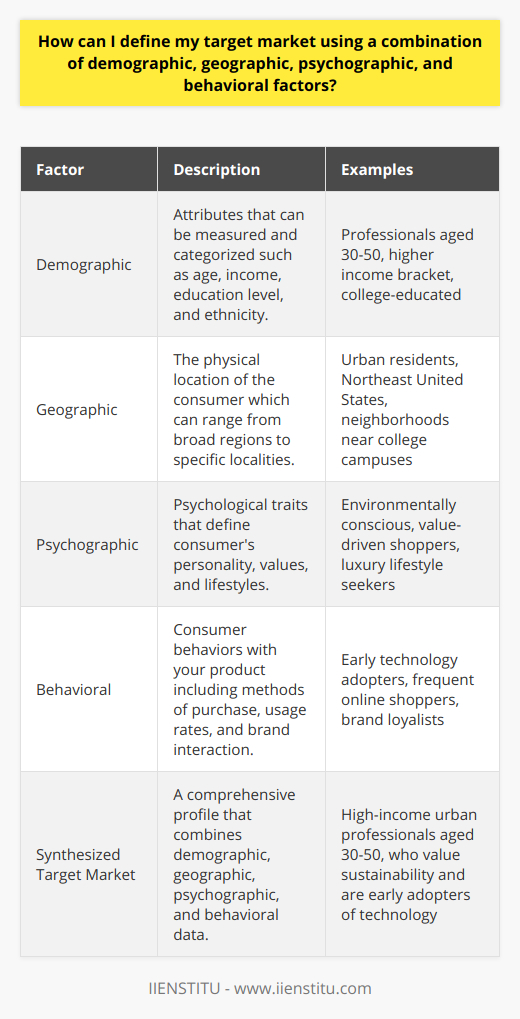
What are the 5 ways to define target market that incorporate not only demographics but also priorities, pain points, and preferences of potential customers?
Identifying Behavioral Patterns
The first way to define a target market goes beyond simple demographics to identify behavioral patterns. Customers' purchasing habits, brand interactions, and product usage rate help in understanding what motivates them.
Analyzing Psychographics
Secondly, psychographics, including lifestyle, attitudes, and values, deepen the understanding of potential customers. This analysis helps in defining the main motivators for making a purchase, addressing emotional needs, and aligning your product offering.
Prioritizing Pain Points
Thirdly, understanding customers' pain points helps in delivering products or services that genuinely solve their problems. By addressing their main issues, you can make your product more appealing and increase customer satisfaction and loyalty.
Assessing Wants and Preferences
The fourth way of target market definition revolves around understanding customers' wants and preferences. This analysis involves knowing which features and benefits the customer values most and aligning your product accordingly.
Understanding Geographic Segmentation
Finally, geographic segmentation plays a vital part in defining your target market. This method goes beyond global location, further analyzing climate, population density, and cultural preferences. By doing so, you can tailor your offerings to meet local needs.
In conclusion, defining your target market requires a multi-faceted approach. You need not only to understand your potential customers' demographics but also their behaviors, preferences, pain points, and the physical location in which they exist. This detailed knowledge allows for the development of products or services that directly address customers' needs and preferences, leading to increased sales and customer loyalty.
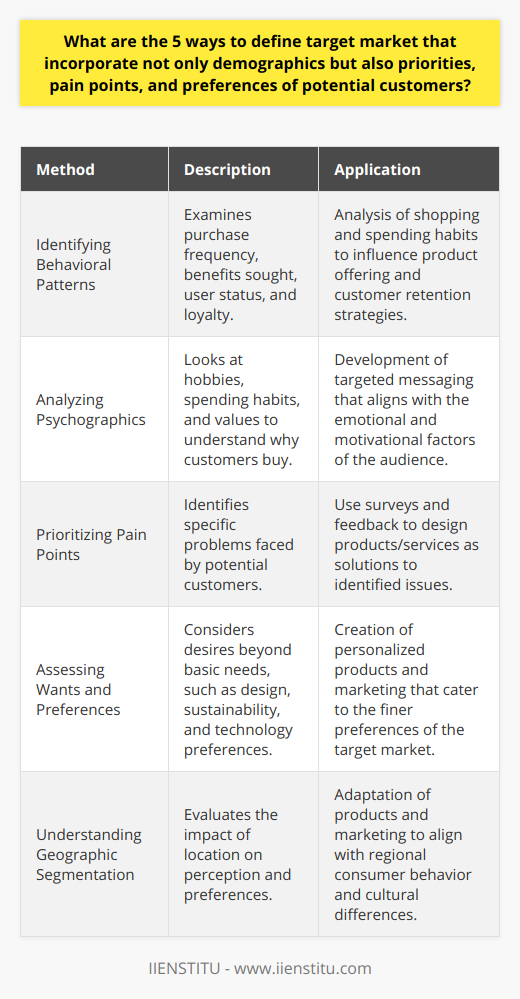
Who is your target market example, when taking into account competitive advantage, consumer needs, and market trends?
Identifying a Target Market
Understanding the audience or target market is crucial for presenting compelling content in a blog post. Valuable insights into the market sector can help tailor and tune the message to resonate with the desired audience.
Understanding Competitive Advantage
A competitive advantage in blogging emerges through superior content creation and a complete understanding of the target market's preferences. For instance, if a blogger focuses on culinary trends, their target market might be amateur chefs and food enthusiasts. By delivering quality content specific to this sector, they leverage their competitive advantage, attracting and retaining a loyal following.
Acknowledging Consumer Needs
Recognizing consumer needs also heavily influences the determination of a blog's target market. These needs often encompass informative, inspiring, or entertaining content. For the culinary blog example, the audience might seek unique recipes, cooking tutorials, or restaurant reviews. Meeting these needs directly substantially boosts audience engagement and retention.
Observing Market Trends
Lastly, paying attention to market trends allows for the expansion and refinement of a blogger's target market. For example, if health and fitness become a significant trend, a culinary blogger can accommodate this by providing healthy recipe options and fitness-friendly food guides. This strategy attracts a broader audience, widening the potential target market.
In conclusion, a blogger's target market revolves around their competitive advantage, their understanding of consumer needs, and their reaction to current market trends. And so, a blog on culinary trends may target amateur chefs and food enthusiasts interested in unique recipes, cooking tutorials, restaurant reviews, and healthy eating.



